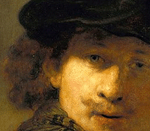
"The Rich Man and the Poor Lazarus"
Hendrick Jansz ter Brugghen (or Terbrugghen) (1588 – 1 November 1629) was a Dutch painter of genre scenes and religious subjects. He was one of the Dutch followers of Caravaggio – the so-called Utrecht Caravaggisti.
He certainly studied Caravaggio's work, as well as that of his followers–the Italian Caravaggisti–such as Orazio Gentileschi. Caravaggio's work had caused quite a sensation in Italy. His paintings were characteristic for their bold tenebroso technique–the contrast produced by clear, bright surfaces alongside sombre, dark sections–but also for the social realism of the subjects, sometimes charming, sometimes shocking or downright vulgar. Other Italian painters who had an influence on Ter Brugghen during his stay in Italy were Annibale Carracci, Domenichino and Guido Reni.
Ter Brugghen's favourite subjects were half-length figures of drinkers or musicians, but he also produced larger-scale religious images and group portraits. He carried with him Caravaggio's influence, and his paintings have a strong dramatic use of light and shadow, as well as emotionally charged subjects. His treatment of religious subjects can be seen reflected in the work of Rembrandt, and elements of his style can also be found in the paintings of Frans Hals and Johannes Vermeer. Peter Paul Rubens described ter Brugghen's work as "...above that of all the other Utrecht artists".